Data silos have become a challenge for businesses of all sizes. Building a profitable business in 2020 can’t be guesswork. It’s critical that you and your team are making informed decisions that lead to growth, profitability, and efficiency.
In order to drive success, you need to understand your business. Technology makes it easier to understand what is working in your business, but also creates new problems, like information overload.
The number of applications used by the typical organization is staggering.
According to a 2019 study by Blissfully, small businesses use 40 apps on average.
Naturally, that number grows substantially to 211 apps when we’re talking about enterprise-level businesses with 1000+ employees.
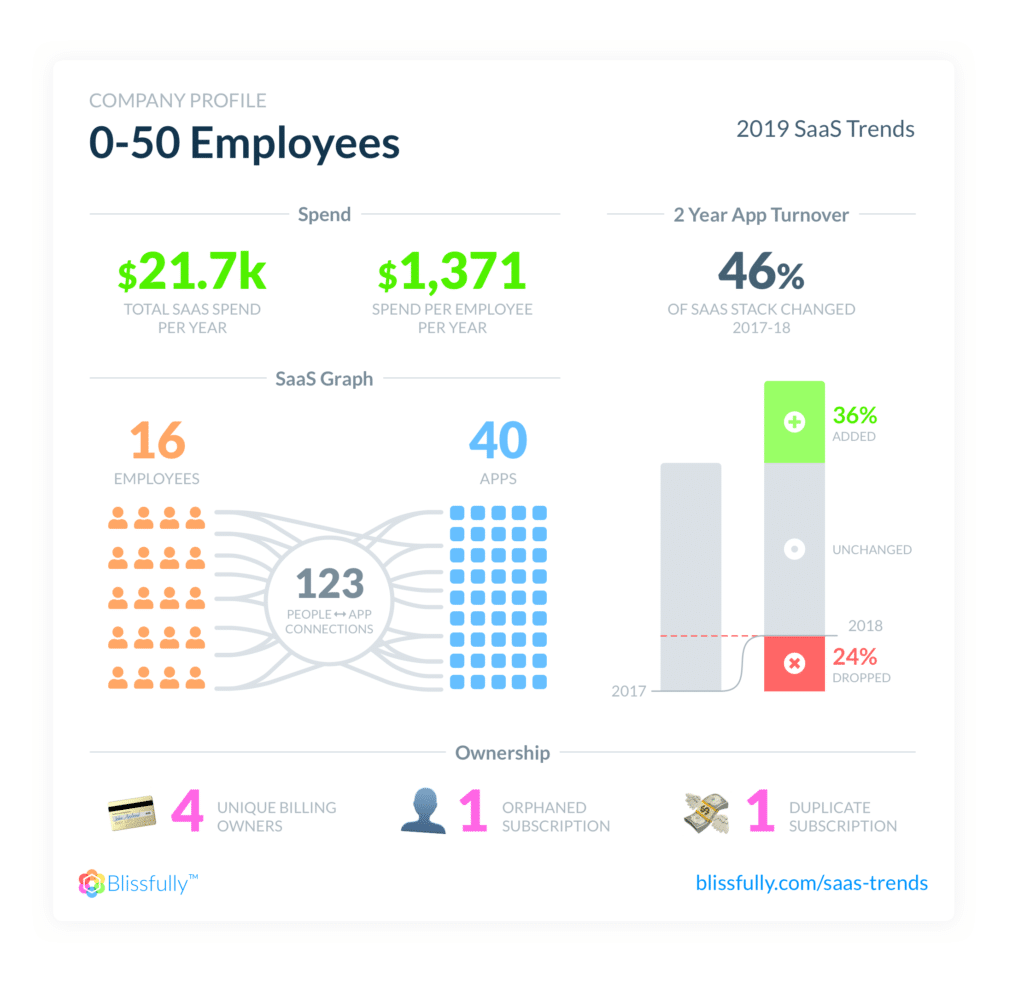
Source: Blissfully
App usage isn’t limited to a single department either. It’s ubiquitous. HR, Sales, Marketing, IT, customer service all have software that they rely on.
These tools allow your employees to perform their jobs more effectively while delivering data-driven opportunities. The data sources paint a picture of how each department is contributing to the great goals of the company.
The irony is that as a leader, the more apps your organization uses, the harder it becomes to make data-driven decisions.
Why?
Because keeping a pulse on your business’ sales, marketing, advertising, finances, web analytics, customer service, SEO, IT, and more as isolated sources of data never give you the complete picture.
In other words, big data doesn’t lead to big insights if you can’t bring it together. You need to think about the data produced by your organization holistically.
As IBM’s own Big Data and Analytics Hub stressed:
“What we’ve learned is that many of the most common challenges associated with big data aren’t really analytics problems. In many cases, these problems are fundamental, even traditional, information integration problems.”
Too much information. A lack of data integration. Departments focusing on their own metrics, KPIs, and data sources.
What’s a primary culprit for businesses being paralyzed by their own magnitudes of data?
Data silos.
Beyond data, silos are a major production killer. There are various silos that exist in the business world.
Table of Contents
What is a silo?
In both their human and digital forms, silos are the bane of productive and profitable businesses.
Patrick Lencioni, in his classic business parable Silos, Politics and Turf Wars, explains why:
Silos – and the turf wars they enable – devastate organizations. They waste resources, kill productivity, and jeopardize the achievement of goals.
And Lencioni isn’t alone. As Co-Founder of Growfusely Pratik Dholakiya put it:
Much as we believe that we are most productive in our little silos, the fundamental fact remains that humans are social animals.
By denying the opportunity to collaborate and cross-pollinate ideas, businesses contribute to their own speedy demise.
According to the Business Dictionary, silo mentality is a “mindset present when certain departments or sectors do not wish to share information with others in the same company.”
What is an organizational silo?
Simply put, organizational silos are divisions within businesses that isolate departments from departments, teams from teams, and eventually even people from people.
Have you ever worked for a company whether the marketing team and the sales team don’t communicate effectively? The marketing teams feel like the leads they’re delivering are not becoming customers, because sales can’t close. Sales teams feel like they can’t close because they don’t have the materials they need to sell which should come from marketing.
Organizational silos are fueled by internal competition, blame-shifting, poor communication structures, and — most of all — “reward and punishment” systems that elevate individual achievement over shared success.
The catch is that none of the departments of a company can exist separately, at least not for long.
If product development and sales are working on separate islands without communication, it won’t be long before the sales team is making empty promises about what the product can actually deliver. That means client expectations won’t meet, and soon enough, customers dwindle.
Additionally, organizational silos substantially damage worker satisfaction, which is a major factor in a company’s long-term financial success.
So the question is: “What does all this have to do with data and decision making?”
As it turns out – everything. The fabric, structure, and leadership of your organization guide employees. But the employees guide the data. If they’re creating or enabling data silos, in essence, your business is working in the dark.
What is a data silo?
A data silo is an isolated source of information in an organization that lacks context and prevents useful interpretation.
If organizational silos are stand-alone containers of people, then it makes sense that data silos are stand-alone containers of data.
They exist separately; without sharing, cross-referencing, interpreting, adding to each other’s self-contained data sets.
What happens when silos exist in your data?
You end up seeing only the analytics produced by each individual application — remember, somewhere between 40 and 200+ — but you never get the whole picture.
Data silo scenario #1
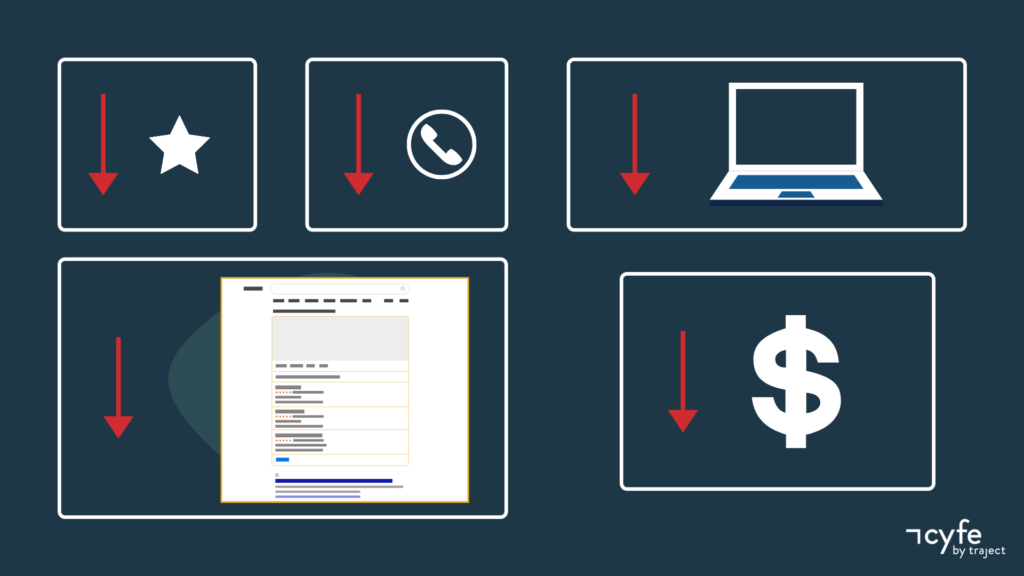
Imagine you’re running a restaurant and people are complaining about curbside delivery in their online reviews. Your average rating starts to decrease which impacts your local rankings on Google. Your lowered rankings result in less website traffic, phone calls, and orders.
If you have a support person focused on your online reviews, a marketer obsessing over your website’s traffic, and a salesperson paying attention to call volume, but nobody is communicating, you might find yourself at a loss.
Why are you seeing such a drop in business?
Data silo scenario #2
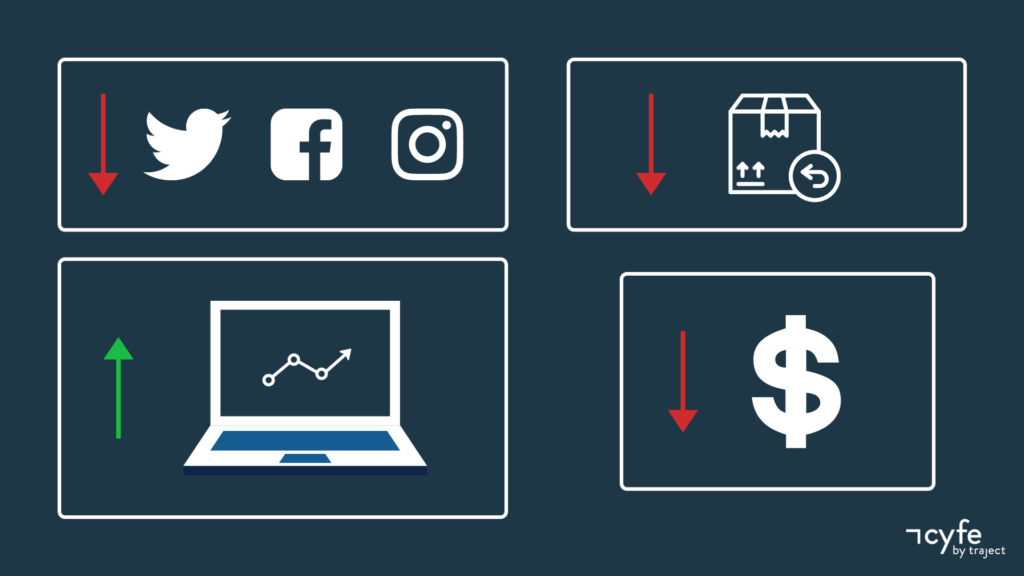
An influencer online has a bad experience with your product and shares their negative experience on social media. All of a sudden you’re seeing a sudden increase in returns and a drop in sales, but your website traffic actually shoots up (due to bad publicity). If your social media team, your marketing team, and your support team are not communicating, everyone might be confused.
Why would website traffic go up, but sales tank?
As IBM put it, “The most common challenges associated with big data … are fundamental, even traditional, information integration problems.”
The industry-leading development firm Laserfiche reinforces this point powerfully:
“Silos are standing in the way of big data. Whether in data sources or organizational structures, silos lead to complicated analytics and lackluster results on big data initiatives.”
Data silo scenario #3
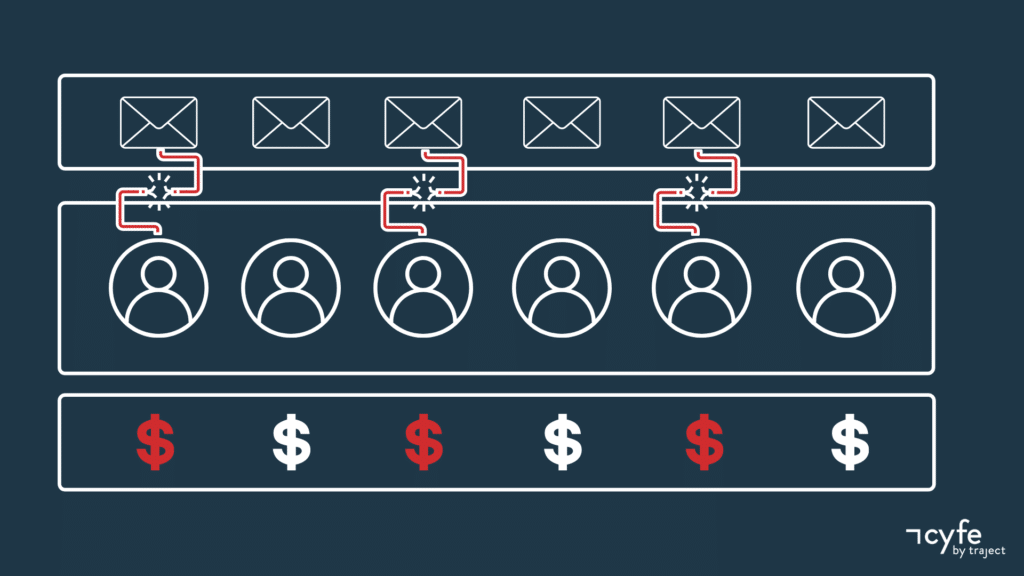
Let’s take the example of a company’s CRM system not being connected with their email marketing application. If that’s the case, then marketing isn’t able to effectively identify the people they need to communicate with: their clients and leads.
Since email has the highest ROI of any marketing channel, that translates to lost revenue.
The bigger your organization, the more likely there are to be both organizational silos and data silos. As you scale, it’s essential to have the right people and processes in place. You need to have an organization that’s aligned towards a common goal.
Communication between departments needs to be:
- Consistent
- Clear
- Bi-directional
- Inclusive
- Focused on achieving mutual goals
Having a strong culture of collaboration within the organization is only the first step. To avoid data silos, it’s imperative to adopt tools that bring together all of your data into one accessible source.
When evaluating holistic solutions to break your data silos, focus your search on tools that can visualize your data in a way that makes it easier to consume regardless of your department and skill set.
You’ll want a tool that can:
- Pull in data sources from all of your company’s applications
- Display on devices that all of your employees have access to (especially when your workforce is working remotely)
- Present data in a way that can tell a story visually
A solution to your data silos
The problem of siloed data is exactly why Cyfe exists.
Cyfe offers the simplest way to bring your data together through an all-in-one dashboard. Building a dashboard that’s customized with the data sources that your company already uses is easy whether you’re:
- A brand new business without a ton of experience with digital technology.
- A sophisticated enterprise that uses custom widgets, SQL data from your own database, and 200+ applications.
- A digital marketing agency that needs to report in real-time to a variety of different small business clients.
Develop multiple dashboards that satisfy all of your company’s needs. Design a full birds-eye view dashboard with all of your essential metrics:
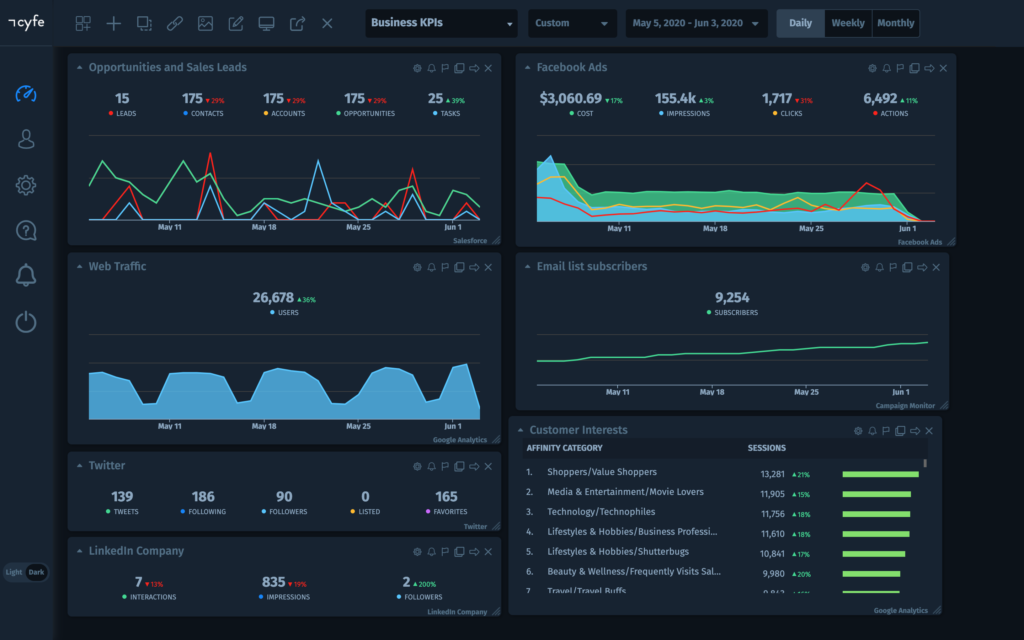
Develop web analytics dashboards to unify all of your website traffic and analytics:
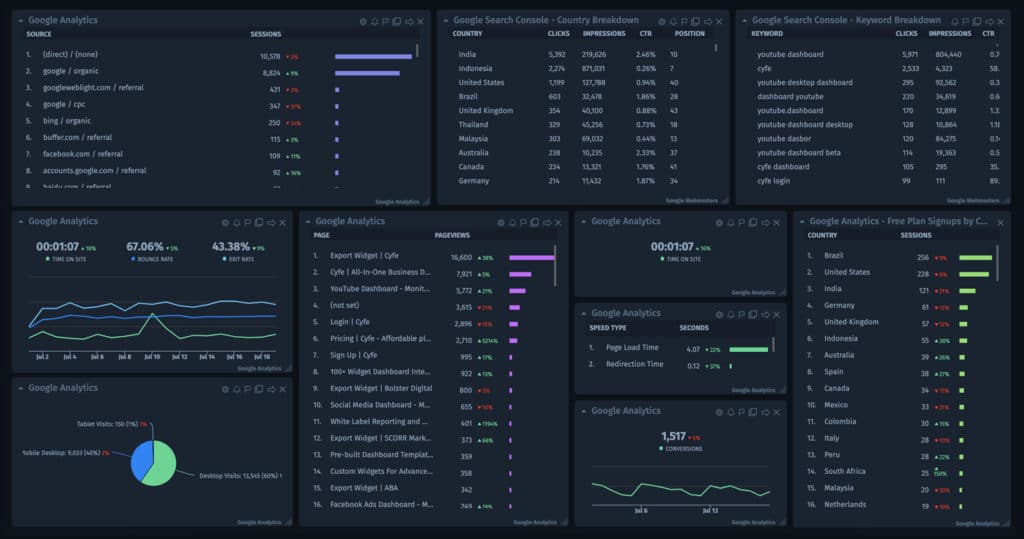
Increase your social media performance by monitoring your full social media dashboard:
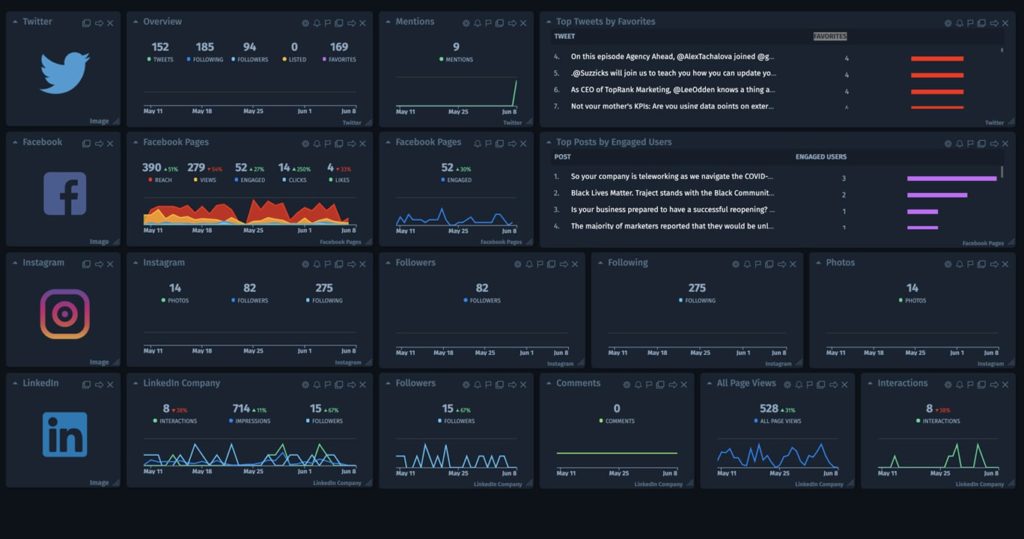
Break the data silos and surface business insights
Ultimately, Cyfe is a valuable tool because it draws this data from the applications your business already uses. If you’re using Salesforce and ActiveCampaign, we’ve got you. Primarily on LinkedIn, using Google Ads, and Mailchimp? No problem. In fact, you can connect Cyfe to the 400+ apps on Zapier with a simple recipe.
That means, instead of one more app to your already crowded plate, Cyfe brings your data out of its silos and together in one place.
Businesses are complex. They are an ecosystem of people, information, and processes directly impacted by external factors.
Data silos can destroy your business, prevent growth, and deteriorate your culture.
Develop a culture of communication and all-in-one holistic business dashboards to break down your data silos, surface data-driven insights, and help your company succeed.


